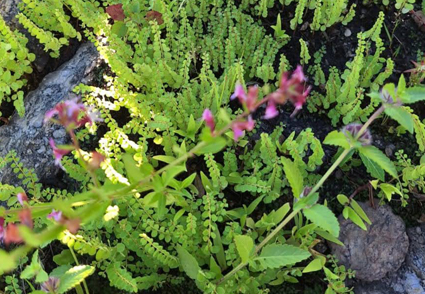Abstract
Phyllanthus catingicola, a new species endemic to Northeastern Brazil, is here described and illustrated based on morphological data. It is known so far in the state of Ceará and is morphologically similar to P. hyssopifolioides in having a stem with non-phyllanthoid branching, secondary branches flat and discreetly winged, leaves present on the main stem and secondary branches, staminate disk with surface smooth and pistillate flowers 6-merous. However, they differ by a set of characters related to the shape of the main stem, number and shape of the staminate sepals, and the shape of the pistillate disk and stigma. We provide photographs of the species in the field, its conservation status, mapped distribution, systematic positioning, and a comparative table to differentiate it from other similar species belonging to Phyllanthus sect. Loxopodium.
References
- Bachman, S., Moat, J., Hill, A.W., Torre, J. & Scott, J. (2011) Supporting red list threat assessments with GeoCAT: Geospatial conservation assessment tool. ZooKeys 150: 117–126. https://doi.org/10.3897/zookeys.150.2109
- Bouman, R.W., Keβler, P.J.A., Telford, I.R.H., Bruhl, J.J., Strijk, J.S., Saunders, R.M.K., Esser, H.J., Falcon-Hidalgo, V. & Welzen, P.C.van (2022) A revised phylogenetic classification of tribe Phyllantheae (Phyllanthaceae). Phytotaxa 540: 1–100. https://doi.org/10.11646/phytotaxa.540.1.1
- Brandegee, T.S. (1905) Plants from Sinaloa. Zoë 5 (10B): 196–226.
- CRIA—Centro de Referência e Informação Ambiental (2024 [continuously updated]) speciesLink network. Available from: https://specieslink.net/search/ (accessed 12 April 2024)
- Forster, J.R. & Forster, G. (1776) Characteres Generum Plantarum ed. 2. J.R. & G. Forster, London, 150 pp.
- Grisebach, A.H.R. (1865) Diagnosen neuer Euphorbiaceen aus Cuba. Nachrichten von der Königlichen Gesellschaft der Wissenschaften und der Georg-August-Universität zu Göttingen 1: 161–181.
- Harris, J.G. & Harris, M.W. (1994) Harris Plant identification terminology: an illustrated glossary. Spring Lake Publishing, Spring Lake, Utah.
- IUCN (2019) Guidelines for using the IUCN red list categories and criteria. Version 11. Standards and Petitions Subcommittee of the IUCN Species Survival Commission, Gland, Switzerland and Cambridge, United Kingdom. Available from: http://www.iucnredlist. org/documents/RedListGuidelines.pdf (accessed 10 January 2024)
- Kunth, K.S. (1817) Euphorbiaceae. In: Humbold, F.W.H.A. von, Bonpland, A.J.A. & Kunth, K.S. (Eds.) Nova Genera et Species Plantarum (quarto ed.) 2. Librairie Grecque-Latine Allemande, Paris, pp. 51–118.
- Martins, E.R., Lima, L.R. & Cordeiro, I. (2014) Phyllanthus (Phyllanthaceae) no estado do Rio de Janeiro. Rodriguésia 65: 405–424. https://doi.org/10.1590/S2175-78602014000200007
- Martins, E.R., Lima, R.L. & Cordeiro, I. (2017) Flora do Espírito Santo: Phyllanthus (Phyllanthaceae). Rodriguésia 68: 1813–1828. https://doi.org/10.1590/2175-7860201768517
- Millspaugh, C.F. (1889) Contributions to North American Euphorbiaceae. Proceedings of the California Academy of Sciences Series 2, 2: 217–230.
- Müller Argoviensis, J. (1863) Euphorbiaceae. Vorläufige Mittheilungen aus dem für DeCandolle’s Prodromus bestimmten Manuscriptüber diese Familie. Linnaea 32: 1–126.
- Müller (Argovensis), J. (1865) Ueber Glochidion (Forst). Flora 48: 369–390.
- Müller Argoviensis, J. (1873) Euphorbiaceae. In: Martius, C.F.P. von & Eichler, A.W. (Eds.) Flora Brasiliensis 11 (2). R. Oldenbourg,Munich & Leipzig, pp. 1–292.
- Orlandini, P., Torres, A.M., Mendes, J.C.R. & Silva, M.J. (2020) Phyllanthus. In: Flora do Brasil 2020. Jardim Botânico do Rio de Janeiro. Available from: https://floradobrasil.jbrj.gov.br/FB24160 (accessed 20 November 2023)
- Orlandini, P., Da Silva, O.L.M., Cordeiro, I. & Souza, V.C. (2023) Phylogenetics of Brazilian phyllocladiferous Phyllanthus (Phyllanthaceae): a new section exclusive from the Atlantic Rain Forest, with morphological and molecular support. Plant Systematics and Evolution 309 (5) 1–36. https://doi.org/10.1007/s00606-023-01871-1
- QGIS Development Team (2015) QGIS Geographic Information System version 2.8.2- Wien. Open Source Geospatial Foundation Project. Available from: http://www.qgis.org/ (accessed 17 March 2025)
- Santiago, L.J.M., Louro, R.P. & Emmerich, M. (2006) Phyllanthus sect. Choretropsis (Euphorbiacaee) in Brazil. Botanical Journal of the Linnean Society 150: 131‒164. https://doi.org/10.1111/j.1095-8339.2006.00459.x
- Silva, M.J. & Sales, M.F. (2007) Phyllanthus L. (Phyllanthaceae) em Pernambuco, Brasil. Acta Botanica Brasilica 21: 79–98. https://doi.org/10.1590/S0102-33062007000100008
- Silva, M.J., Alonso, A.A. & Santos, I.S. (2022) A new Critically Endangered species of stone breaker (Phyllanthus, Phyllanthaceae) from Central Brazil, with notes on its leaf and stem anatomy. Phytotaxa 530: 53–64. https://doi.org/10.11646/phytotaxa.530.1.4
- Thiers, B. (2024 [continuously updated]) Index Herbariorum: A global directory of public herbaria and associated staff. New York Botanical Garden’s Virtual Herbarium, New York. Available from: http://sweetgum.nybg.org/ih/ (accessed 28 June 2024)
- Torres, D.S.C., Cordeiro, I. & Giulietti, A.M. (2003) O gênero Phyllanthus L. (Euphorbiaceae) na Chapada Diamantina, Bahia, Brasil. Acta Botanica Brasilica 17: 265–278. https://doi.org/10.1590/S0102-33062003000200009
- Torres, A.M., Cordeiro, W.P.F.S., Athiê-Souza, S.M. & Sales, M.F. (2022) Phyllanthaceae in the Atlantic Forest of northeastern Brazil. Biota Neotropica 22: e20211246. https://doi.org/10.1590/1676-0611-bn-2021-1246
- Torres, A.M. & Silva, M.J. (2022) Phyllanthus longipetiolatus (Phyllanthaceae), a new species from São Paulo State, Brazil. Phytotaxa 567 (3): 287–293. https://doi.org/10.11646/phytotaxa.567.3.8
- Torres, A.M. & Silva, M.J. (2023) Anatomical and macromorphological data support a new species of Phyllanthus (Phyllanthaceae) from Southeastern Brazil. Phytotaxa 601: 185–196. https://doi.org/10.11646/phytotaxa.601.2.5
- Walter, T. (1788) Flora caroliniana. J. Fraser, London, 263 pp.
- Webster, G.L. (1955) Studies of the Euphorbiaceae, Phyllanthoideae I. Taxonomic notes on the West Indian species of Phyllanthus. Contributions from the Gray Herbarium of Harvard University 176: 45–63. https://doi.org/10.5962/p.336373
- Webster, G.L. (1956) A monographic study of the West Indian species of Phyllanthus. Journal of the Arnold Arboretum 37: 340–357. https://doi.org/10.5962/p.324651
- Webster, G.L. (2002) A synopsis of the Brazilian taxa of Phyllanthus section Phyllanthus (Euphorbiaceae). Lundelia 5: 1–26. https://doi.org/10.25224/1097-993X-5.1.1


